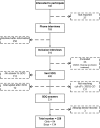Behavioural characteristics in externalising children with low and elevated risk for dental caries
- PMID: 27830462
- PMCID: PMC5126186
- DOI: 10.1007/s40368-016-0256-6
Behavioural characteristics in externalising children with low and elevated risk for dental caries
Abstract
Aim: To compare two groups of children with externalising behaviour problems, having low and elevated caries risk, respectively. Those parameters were assessed in relation to behavioural characteristics and family structure, and to compare the caries risk assessment and gender differences in relation to children in general in the Region of Västra Götaland, Sweden.
Methods: Families (228) with children, aged 10-13 years, participating in parent training programmes, were recruited. Parents provided information through questionnaires regarding parental knowledge and monitoring, family warmth and conflict and family structure. Children's behavioural characteristics, based on the Strength and Difficulties Questionnaire and the Disruptive Behaviour Disorder rating scale, were used as outcome. Data about caries risk assessment were obtained from dental records.
Results: Children in the elevated caries risk group showed higher mean values for conduct problems as well as impulsivity. Parents of the children in the elevated caries risk group reported more parental solicitation and less family conflicts. Children with an elevated caries risk lived more often in households with more than two children and had more often a father from a non-Nordic country.
Conclusion: There were statistically significant more children with an elevated caries risk in the study group compared to children in general in the Region of Västra Götaland, both totally and within gender. Differences were observed with regard to behavioural characteristics in externalising children with an elevated risk for caries. Increased knowledge regarding behavioural characteristics in externalising children is an important parameter to be considered in caries risk assessment.
Keywords: Child behaviour; Conduct problems; Dental caries; Disruptive behaviour results disorder.
Conflict of interest statement
Compliance with ethical standards Conflicts of interest The authors report no conflicts of interest and are alone responsible for the content and writing of the paper.
Figures


Similar articles
-
Oral health and oral health risk behaviour in children with and without externalising behaviour problems.Eur Arch Paediatr Dent. 2018 Jun;19(3):177-186. doi: 10.1007/s40368-018-0346-8. Epub 2018 May 15. Eur Arch Paediatr Dent. 2018. PMID: 29766414 Free PMC article.
-
[A PhD completed 7. Just add positivity? Dental caries, obesity and problem behaviour in children: the role of parents and family -relations].Ned Tijdschr Tandheelkd. 2016 Nov;123(11):554-556. doi: 10.5177/ntvt.2016.11.16213. Ned Tijdschr Tandheelkd. 2016. PMID: 27834410 Dutch.
-
Parenting practices and children's dental caries experience: A structural equation modelling approach.Community Dent Oral Epidemiol. 2017 Dec;45(6):552-558. doi: 10.1111/cdoe.12321. Epub 2017 Jul 27. Community Dent Oral Epidemiol. 2017. PMID: 28748528
-
[Homosexual parenthood and child development: present data].Encephale. 2012 Feb;38(1):10-5. doi: 10.1016/j.encep.2011.05.005. Epub 2011 Jul 5. Encephale. 2012. PMID: 22381718 Review. French.
-
Stability and change in externalising behaviours.Eur Arch Psychiatry Clin Neurosci. 1998;248(1):4-13. doi: 10.1007/s004060050012. Eur Arch Psychiatry Clin Neurosci. 1998. PMID: 9561348 Review.
Cited by
-
Integrating oral and social factors in individual caries risk assessments in preschool children-a registry-based study.Eur Arch Paediatr Dent. 2024 Oct;25(5):695-705. doi: 10.1007/s40368-024-00928-0. Epub 2024 Aug 5. Eur Arch Paediatr Dent. 2024. PMID: 39103739 Free PMC article.
-
Association of Age and Temperamental Traits with Children's Behaviour during Dental Treatment.Int J Environ Res Public Health. 2022 Jan 29;19(3):1529. doi: 10.3390/ijerph19031529. Int J Environ Res Public Health. 2022. PMID: 35162552 Free PMC article.
-
Oral health and oral health risk behaviour in children with and without externalising behaviour problems.Eur Arch Paediatr Dent. 2018 Jun;19(3):177-186. doi: 10.1007/s40368-018-0346-8. Epub 2018 May 15. Eur Arch Paediatr Dent. 2018. PMID: 29766414 Free PMC article.
References
-
- American Psychiatric Association . Diagnostic and statistical manual of mental disorders: DSM-IV-TR. Washington, DC: American Psychiatric Association; 2000.
-
- Bjornsdotter A. Evaluation of family check-up and icomet: effectiveness as well as psychometrics and norms for parent rating scales. Uppsala: Acta Universitatis Upsaliensis; 2014.
MeSH terms
LinkOut - more resources
Full Text Sources
Other Literature Sources
Medical

